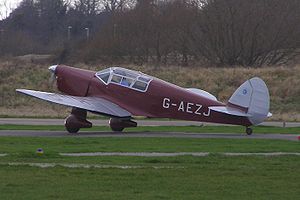Design and development
Built by Percival Aircraft of Gravesend and Luton (after 1936 when Percival Aircraft became a Limited Company), the 'K-Series' Vega Gull was a development of their earlier 'D-Series' Gull . The main changes from the earlier design were the provision of a fourth seat, dual controls and flaps. The fuselage was widened and the wingspan increased. Increases in drag were compensated for by reducing parasitic drag from exterior fittings such as hinges and actuation horns. This work was largely attributable to the arrival at Percivals of the draughtsman Arthur Bage. [1] Thus, the Vega Gull was very nearly as fast as the slimmer Gull Six. Payload, range and utility were all much improved. The prototype G-AEAB first flew from Gravesend in November 1935. [2]
The Vega Gull retained the de Havilland Gipsy Six air-cooled inline engine introduced in the D.3 Gull Six of 1934. Most examples were fitted with the optional DH Gipsy Six Series II engine in conjunction with the DH-PD30 VP airscrew. The final Mk II examples were fitted with a curved windscreen (the earlier examples had a multi-faceted windscreen of flat panels) similar in appearance to the early marks of the Proctor. [3]
Operational history
The Vega Gull VP-KCC named "Messenger" was used by Beryl Markham on her transatlantic flight on 4-5 September 1936; this was the first non-stop solo crossing by a woman, and the first east-to-west solo crossing. [4] [5]
Two early production Vega Gulls were entered in the Schlesinger Race from England to Johannesburg, South Africa. C.W.A. Scott and Giles Guthrie flying Vega Gull G-AEKE were the only finishers, landing at Rand Airport on 1 October 1936. [6] The aircraft had left Portsmouth 52 hours 56 minutes 48 seconds earlier. With the publicity of the win, Percival set up a production line at larger premises at Luton. The new type was an immediate success with production running to 90, the last production aircraft having its maiden flight on 27 July 1939.
The Vega Gull was widely used by British and Commonwealth aviators during the later years of the "Golden Age" of record-setting aviation during the 1930s. Alex Henshaw, Jim Mollison, Amy Johnson, Beryl Markham, C.W.A. Scott and others, won races and broke records to, among other places, South Africa, South America, Australia and New Zealand.
In addition to civil orders, 15 were ordered by the Air Ministry. Of these, 11 served with 24 Squadron Royal Air Force on communications duties and two were issued to the Fleet Air Arm, which was yet to come under Admiralty control. [2] The remaining two were used by the British air attachés in Buenos Aires and Lisbon. A third aircraft for use by the British air attaché in Berlin was seized by the Germans at the outbreak of the Second World War. [7] It remains unclear whether the Luftwaffe subsequently used this machine.
After the outbreak of war Vega Gulls were requisitioned for military use. In the UK, 21 were impressed in 1939–40, 14 for the RAF and seven for the FAA. Two aircraft were impressed in each of Australia and India, while one other was "called to the colours" in New Zealand. [7]
By the end of the war the Vega Gull had been largely supplanted by the Proctor, of which more than 1,100 were manufactured. Despite the obvious drawbacks of its wooden airframe in terms of durability, the Vega Gull compares favourably with more modern designs. To save hangar space, the wings could be folded to reduce the space needed for storage.

The Miles M.14 Magister is a two-seat monoplane basic trainer aircraft designed and built by the British aircraft manufacturer Miles Aircraft. It was affectionately known as the Maggie. It was authorised to perform aerobatics.

The de Havilland Express, also known as the de Havilland D.H.86, was a four-engined passenger aircraft manufactured by the de Havilland Aircraft Company between 1934 and 1937.

The de Havilland DH.80A Puss Moth is a British three-seater high-wing monoplane aeroplane designed and built by the de Havilland Aircraft Company between 1929 and 1933. It flew at a speed approaching 124 mph (200 km/h), making it one of the highest-performance private aircraft of its era.

The Percival Gull was a British single-engined monoplane, first flown in 1932. It was successful as a fast company transport, racing aircraft and long-range record breaker. It was developed into the Vega Gull and the Proctor.

The de Havilland DH.60 Moth is a 1920s British two-seat touring and training aircraft that was developed into a series of aircraft by the de Havilland Aircraft Company.

The Percival Prentice was a basic trainer of the Royal Air Force in the early postwar period. It was a low-wing monoplane with a fixed tailwheel undercarriage. Front seating was in a side-by-side configuration with a rear seat provided.

The de Havilland DH.90 Dragonfly is a 1930s British twin-engined luxury touring biplane built by the de Havilland Aircraft Company at Hatfield Aerodrome.

The Spartan Cruiser was a 1930s British three-engined transport monoplane for 6 to 10 passengers built by Spartan Aircraft Limited at East Cowes, Isle of Wight. It was a development of the Saro-Percival Mailplane for passenger use.

The de Havilland Gipsy Queen is a British six-cylinder aero engine of 9.2 litres (560 cu in) capacity that was developed in 1936 by the de Havilland Engine Company. It was developed from the de Havilland Gipsy Six for military aircraft use. Produced between 1936 and 1950 Gipsy Queen engines still power vintage de Havilland aircraft types today.

The Percival Proctor is a British radio trainer and communications aircraft of the Second World War. The Proctor is a single-engined, low-wing monoplane with seating for three or four, depending on the model.

The Percival Prince is a British light transport of the early postwar period. It was a twin-engine, high-wing, cantilever monoplane of all-metal stressed-skin construction; the undercarriage was of retractable, tricycle type.

The Miles M.17 Monarch was a British, light, touring aeroplane of the 1930s. It was a single-engine, three-seat, cabin monoplane with a fixed, tailwheel undercarriage.

The Percival Mew Gull is a British racing aircraft of the 1930s. It is a small single-engined single-seat low-wing monoplane of wooden construction, normally powered by a six-cylinder de Havilland Gipsy Six piston engine. During the second half of the 1930s Mew Gulls dominated air-racing in the UK, consistently recorded the fastest times until the outbreak of war stopped all civilian flying in late 1939. In addition examples set many long-distance records. Its top speed was 265 mph (425 km/h) on a modest 205 hp (153 kW) in its final 1939 form.
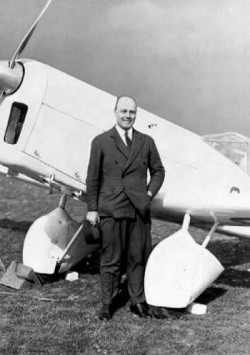
Edgar Wikner Percival was a noted Australian aircraft designer and pilot whose aircraft were distinguished by speed and grace. Percival went on to set up the Percival Aircraft Company, a British aircraft company.
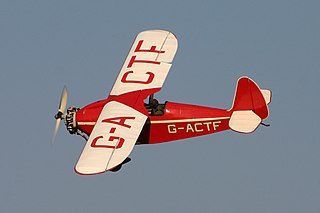
The Comper C.L.A.7 Swift is a British 1930s single-seat sporting aircraft produced by Comper Aircraft Company Ltd of Hooton Park, Cheshire.

The Miles Hawk Major was a 1930s British two-seat light monoplane, developed by Miles Aircraft from the Miles Hawk in order to take advantage of the new inverted de Havilland Gipsy Major engine. When fitted with the longer Gipsy Six in place of the forward crew member, it was known as the Miles Hawk Speed Six.

The Miles M.3 Falcon is a 1930s British three/four-seat cabin monoplane aircraft designed by Miles Aircraft Limited.
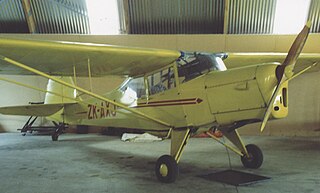
The Auster J/5 Adventurer is a British-built three-seat light high-wing monoplane of the late 1940s.

Flight Lieutenant Charles William Anderson Scott, AFC was an English aviator. He won the MacRobertson Air Race, a race from London to Melbourne, in 1934, in a time of 71 hours.
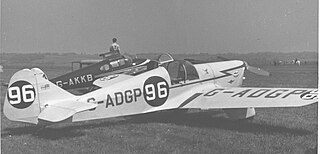
The Miles Hawk Speed Six was a 1930s British two-seat light monoplane, developed by Miles Aircraft from the Miles Hawk Major by fitting the longer and more powerful Gipsy Six engine and removing the forward crew member.
This page is based on this
Wikipedia article Text is available under the
CC BY-SA 4.0 license; additional terms may apply.
Images, videos and audio are available under their respective licenses.
